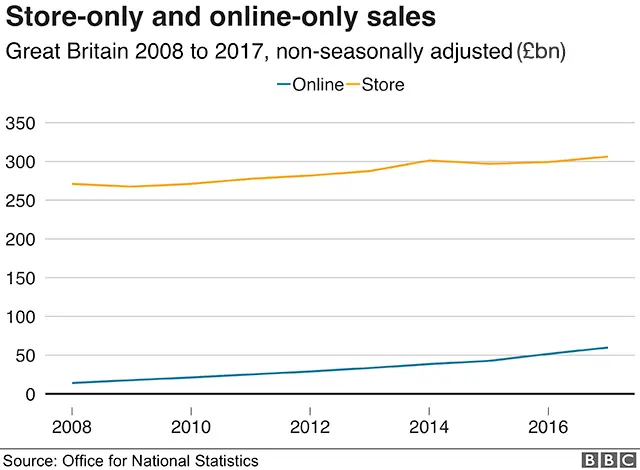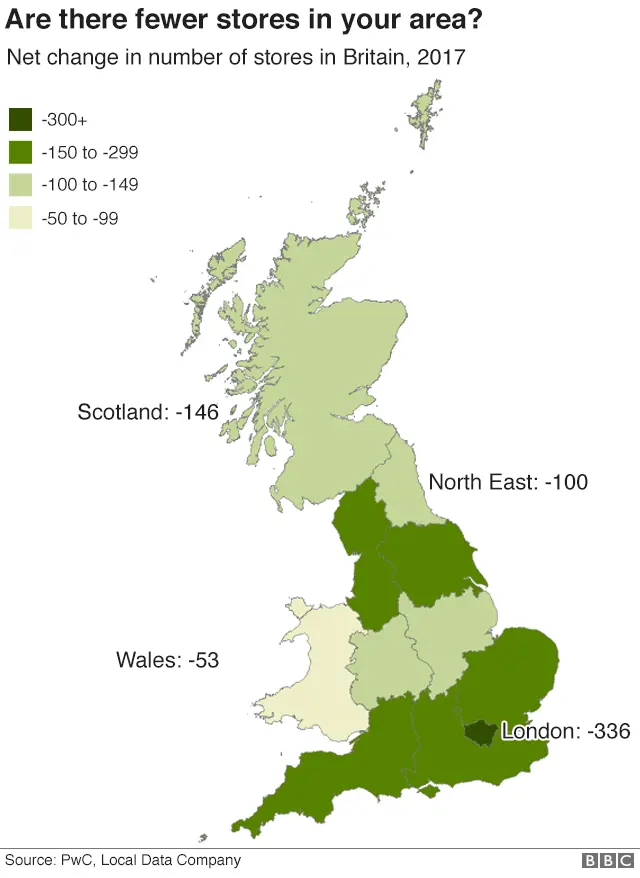High street crisis: Charting how we spend our money
 Getty Images
Getty ImagesRetailers large and small have been facing tough times in Britain.
Store chains like House of Fraser, Marks & Spencer and New Look have been forced to shut up some of their shops.
They blame their struggles on factors such as weak sales, rising costs and competition from online retailers.
So BBC News asks, what are people in the UK spending their money on, and where?
1. How much are we spending?
Over the last 10 years, the amount of money people have been spending in the retail sector has been on the up, according to the Office for National Statistics (ONS).
In 2017, consumers spent around £366bn in shops and online (excluding fuel).

That was an increase of 4.57% from £350bn the year before, not accounting for inflation.
While sales have been increasing, the British Retail Consortium has reported that shop prices increased for the first time in five years in August, with the recent heatwave driving up the cost of food.
2. What do people spend most on?

For every pound spent in the retail sector in 2017, 42p was spent in non-food stores like clothes shops and department stores and 9p went to other retailers like market stalls or mail order companies.
The latest statistics from the ONS show that the last three months of summer, from June to August, saw an increase in the amount consumers bought.
Food sales did well with the good weather, with growth of 3.2% in comparison with last year. Retailers have also suggested that the World Cup boosted sales of televisions.
3. Where do we spend the most?
In Great Britain, we spend more money in shops than we do online. But, the growth of online sales is increasing rapidly.
Online sales in 2017 increased by 15.9% to £59.8bn in comparison with 2016, while in-store sales saw a jump of only 2.4%.

That means that nearly one-sixth of every pound was spent online last year, with customers spending most in the months leading up to Christmas.
With chains like Toys R Us and Maplin recently collapsing, some experts have said that the rise of online, increasing staff costs and rising business rates have created a "perfect storm" for retailers.
4. Are more shops closing?
The number of new shops opening in Great Britain is declining, while store closures are becoming more common.
There was a total loss of 1,772 stores in 2017 across the top 500 British town centres, according to a study by consultancy PwC.

An average of 16 high street shops closed every day in 2017, with more than 700 of the closures coming among fashion retailers.
Beauty product stores, coffee shops and cafés, and ice cream parlours showed the highest increase in net store numbers last year.
Lisa Hooker, UK consumer markets leader at PwC, said: "Shopping budgets remain tight. If you ask consumers what their spending priorities are, they remain food - due to inflation- and their main holiday.
"When they do spend in other areas, consumers are looking for affordable, fun experiences, hence the growing high street presence in areas such as beauty, coffee and tea shops, bookshops and ice cream parlours. Essentially, it is the areas where you can entertain the family at a relatively low cost."
